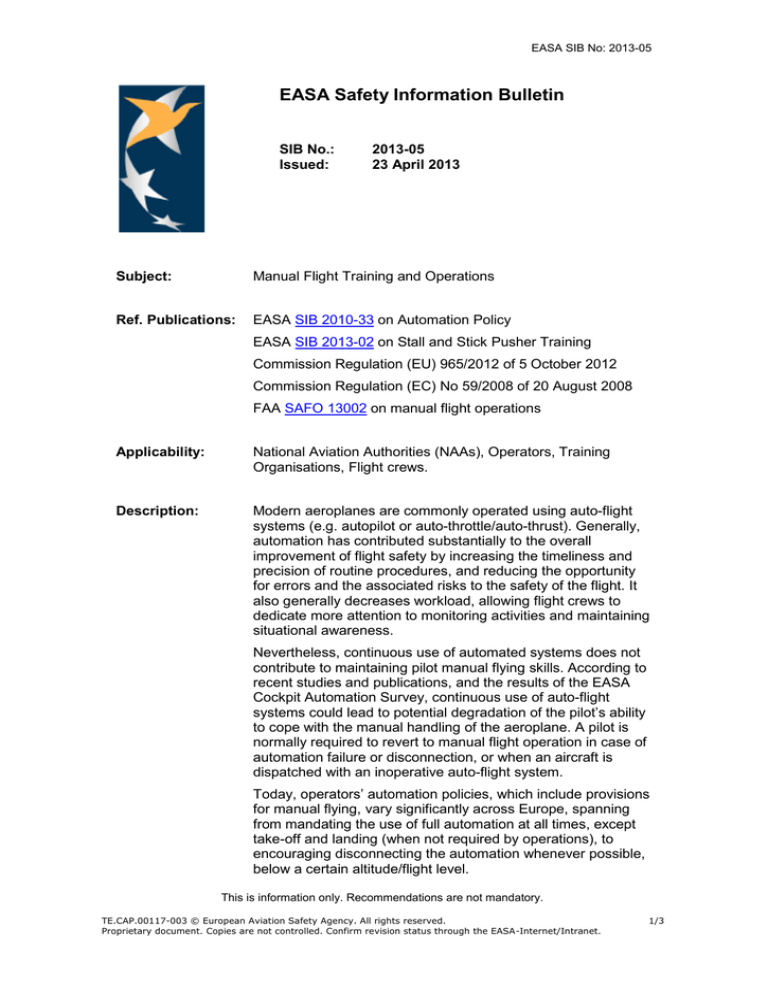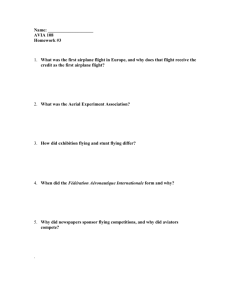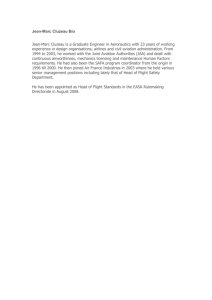
EASA SIB No: 2013-05
EASA Safety Information Bulletin
SIB No.:
Issued:
2013-05
23 April 2013
Subject:
Manual Flight Training and Operations
Ref. Publications:
EASA SIB 2010-33 on Automation Policy
EASA SIB 2013-02 on Stall and Stick Pusher Training
Commission Regulation (EU) 965/2012 of 5 October 2012
Commission Regulation (EC) No 59/2008 of 20 August 2008
FAA SAFO 13002 on manual flight operations
Applicability:
National Aviation Authorities (NAAs), Operators, Training
Organisations, Flight crews.
Description:
Modern aeroplanes are commonly operated using auto-flight
systems (e.g. autopilot or auto-throttle/auto-thrust). Generally,
automation has contributed substantially to the overall
improvement of flight safety by increasing the timeliness and
precision of routine procedures, and reducing the opportunity
for errors and the associated risks to the safety of the flight. It
also generally decreases workload, allowing flight crews to
dedicate more attention to monitoring activities and maintaining
situational awareness.
Nevertheless, continuous use of automated systems does not
contribute to maintaining pilot manual flying skills. According to
recent studies and publications, and the results of the EASA
Cockpit Automation Survey, continuous use of auto-flight
systems could lead to potential degradation of the pilot’s ability
to cope with the manual handling of the aeroplane. A pilot is
normally required to revert to manual flight operation in case of
automation failure or disconnection, or when an aircraft is
dispatched with an inoperative auto-flight system.
Today, operators’ automation policies, which include provisions
for manual flying, vary significantly across Europe, spanning
from mandating the use of full automation at all times, except
take-off and landing (when not required by operations), to
encouraging disconnecting the automation whenever possible,
below a certain altitude/flight level.
This is information only. Recommendations are not mandatory.
TE.CAP.00117-003 © European Aviation Safety Agency. All rights reserved.
Proprietary document. Copies are not controlled. Confirm revision status through the EASA-Internet/Intranet.
1/3
EASA SIB No: 2013-05
This SIB is issued to remind NAAs and operators of the
importance of manual flying during recurrent simulator training
and also, when appropriate, during flight operations.
The overall aim is to reach an appropriate balance between the
use of automation and the need to maintain pilot manual flying
skills.
A similar recommendation has been issued through other
publications, such as the FAA SAFO 13002.
Recommendations: Operators are encouraged to consider incorporating emphasis
of manual flight operations, as a means of maintaining basic
flying skills, into training (initial and recurrent) and, when
feasible, line operations.
Operational principles should be developed by operators and
included in their automation policy. The operator should identify
appropriate opportunities for pilots to practice their manual
flying skills, taking into account factors such as:
Phase of flight;
Workload conditions;
Altitude/Flight Level (non-Reduced Vertical Separation
Minima (RVSM);
Meteorological conditions;
Traffic density;
Air Traffic Control (ATC) and Air Traffic Management (ATM)
procedures;
Pilot and crew experience;
Operator operational experience.
Note: This is not a complete list of potential factors.
It is also important that pilots clearly understand the
circumstances under which automated systems have to be
used, such as during high workload conditions, while operating
in traffic congested airspaces, or when following airspace
procedures that require the use of autopilot for precise
operations.
Therefore, the conditions and procedures for manual flying
should be clearly described in the operator’s manual and
agreed with the competent NAA.
Furthermore, tools like Safety Management Systems (SMS)
and Flight Data Monitoring (FDM) should be used by operators
to closely monitor the potential impact on the number,
magnitude and pattern of deviations from consolidated average
flight precision, to effectively balance the benefits and the
drawbacks of manual flying and adjust policies accordingly.
Operators implementing an Alternative Training and
This is information only. Recommendations are not mandatory.
TE.CAP.00117-003 © European Aviation Safety Agency. All rights reserved.
Proprietary document. Copies are not controlled. Confirm revision status through the EASA-Internet/Intranet.
2/3
EASA SIB No: 2013-05
Qualification Programme (ATQP) should tailor their training
programme based on available data.
Competent NAA’s and operators should work together to
ensure that the content of this SIB is incorporated into
operational policies, provided to pilots during theoretical
training, and reinforced during practical training.
Contact(s):
For further information contact the Safety Information Section,
Executive Directorate, EASA. E-mail: ADs@easa.europa.eu.
This is information only. Recommendations are not mandatory.
TE.CAP.00117-003 © European Aviation Safety Agency. All rights reserved.
Proprietary document. Copies are not controlled. Confirm revision status through the EASA-Internet/Intranet.
3/3


